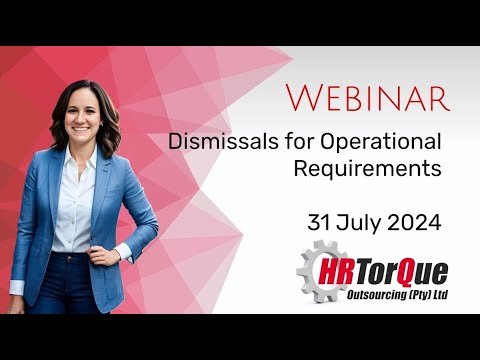In today’s dynamic business environment, navigating complex issues like retrenchments can be daunting, especially for small and medium enterprises (SMEs). Our recent webinar aimed to simplify this process by providing a clear, jargon-free explanation of the requirements outlined in the Labour Relations Act (LRA). Whether you are considering operational adjustments or want to better understand your obligations, this session offers practical insights and guidance tailored specifically to SMEs.
Key topics covered
- Overview of the retrenchment process: Understanding the stages involved in a retrenchment, from initial planning to final execution.
- Legal requirements under the Labour Relations Act: A breakdown of what the LRA mandates, ensuring that your business stays compliant with the law.
- Steps to ensure compliance and fairness: Practical advice on how to conduct retrenchments in a manner that is both legally sound and ethically fair.
Webinar highlights
During the webinar, we received insightful questions from attendees, reflecting the real-world challenges businesses face when dealing with retrenchments. Here are some of the key questions discussed:
Q: If we decide to buy a company and only need, say, 25 people out of 65, would the same retrenchment process apply?
A: Under South African law, you cannot use the retrenchment process in a Section 197 transfer. When buying a business as a going concern, the new owner is legally obligated to take over the existing employees. Retrenching staff as part of the transfer is not allowed. If there are plans to reduce the workforce, the retrenchment process must be completed by the current owner before the sale. It is also crucial to consider aspects such as whether leave balances and years of service will carry over in the transfer. These details require careful attention to ensure compliance.
Q: Is voluntary retrenchment the best option as a starting point?
A: Voluntary retrenchments can be a good initial step as they may help avoid compulsory layoffs, but they should be approached with caution to ensure fairness and compliance.
Q: How much notice pay do you have to pay out?
A: Notice pay requirements are primarily governed by the BCEA, but the specifics can vary depending on the employee’s contract and length of service. According to the BCEA:
- If an employee has been with the company for less than six months, it is one week.
- For employees with six months to a year of service, it is two weeks.
- For employees with more than a year of service, it is four weeks.
- It is important to refer to the employee’s contract, as it may stipulate different periods. If the contract provides for a longer notice period than the BCEA, the contractual terms would apply.
Q: If an employee has worked for two years and 10 months, is the 10-month period also included in the severance pay calculation?
A: According to the BCEA, severance pay is calculated based on completed years of service only. The 10-month period is not automatically included in the severance calculation. However, as an employer, you may choose to round up the months to make it a full year, which would increase the severance pay. If you decide to do this, it is important to inform the employee that the additional period has been included as part of their retrenchment package.
Q: Can an employee claim UIF, with voluntary retrenchment?
A: Yes, an employee can claim UIF if they have accepted a voluntary retrenchment package. However, if the separation is due to a mutual agreement that is not considered a retrenchment, the employee may not be eligible to claim UIF. It is important to distinguish between voluntary retrenchment and mutual separation agreements when determining UIF eligibility.
Attendee feedback
“The webinar was incredibly informative, especially the section on legal compliance. It clarified a lot of the grey areas we had about the retrenchment process.” – Cheryl
“I appreciated the practical advice provided, particularly on handling voluntary retrenchments.” – Fiona
If you missed the live session, don’t worry – you can still catch up by watching the replay here. Be sure to like and share the video, and don’t forget to subscribe to our YouTube channel for more valuable content.
At HRTorQue, we are committed to providing comprehensive HR, payroll, accounting and tax services to help organisations navigate HR challenges effectively. Stay tuned for more insightful webinars and resources designed to support your HR needs.
Feel free to arrange a complimentary 15-minute consultation with one of our HR consultants at your convenience.


